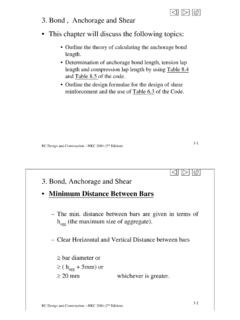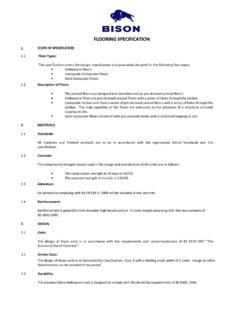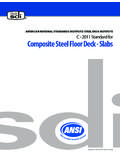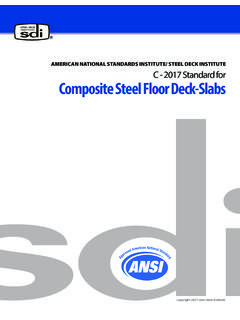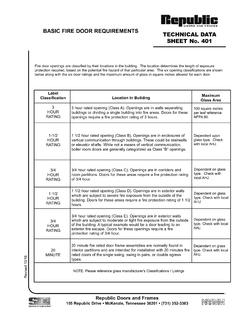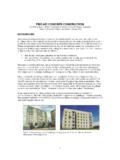Transcription of 1 – Structural Steelwork 1. Structural Steel Sections
1 1 of 19 1 Structural Steelwork 1. Structural Steel Sections . Structural Steel Sections can be classified into various groups according to their shapes.. A Steel section is designated by the serial size in millimeters (mm) and the mass per unit length in kilograms per metre (kg/m), h x b x mass.. For example, a universal beam of x mm at 388 kg/m is designated 914 x 419 x 388 beam. Universal Beam (UB) . Universal beams are rolled with parallel flanges.. The depth of section is about double of the width of the flanges. Universal Beam 2 of 19 Universal Column (UC) . Universal Columns are rolled with parallel flanges.. Generally, the depth of the section and the width of the flanges are approximately equal. Joist . Joists are rolled with 8 tapered flanges.. They provide a useful range of Sections smaller than those in the universal beam Channel section There are two types of channel Sections .
2 Parallel flange channels . Taper flange channels with 5 tapered flanges. Structural Tee . Structural tees may be cut from universal beams or universal columns.. They are designated by their nominal width of flange, depth of stalk and mass per metre, b x A x mass. Angle . Angles are designated by their nominal leg lengths and thickness (in mm), 50 x 30 x 5 Universal Column Joist Taper flange channel Parallel flange channel Structural Tee cut form UB Structural Tee cut form UC 3 of 19 Sand Blasting (Source: Jufri & Wellmen). There are two types of Structural Steel angles : a. equal leg angles b. unequal leg angles Hollow Sections . Available hollow Sections are round, square and rectangular.. Hollow Sections are specified by their size and thickness. 2. Fabrication Fabrication is carried out in a fabrication workshop, where the Steel Sections undergo the following stages of treatments: 1.
3 The Steel Sections are first cleaned to remove dirt, mill-scales and any corrosion by sand blasting. They are then painted with a priming coat of paint within 2 hours. 2. The Sections are cut to the correct length by sawing or cropping. 3. Holes are drilled or punched on the workpiece for bolted connections. Sometimes the edge of a workpiece is machined for welded connections. 4. Jointing accessories (fittings), such as angle cleats, plates, bases, etc., are manufactured by drilling, punching and cropping machines at the same time. 5. To reduce the site works, the main components and the fittings are then assembled into modules. The size of each module should be convenience for lifting and transportation. 6. The components are then transferred to the dispatch bay to await transport to site. Equal leg angle Unequal leg angle 4 of 19 3.
4 Connection . Steelwork can be connected by bolting or welding Bolting connection Black bolt . Black bolts are made of mild Steel , unpolished and the least expensive.. They are used in clearance hole, the hole diameter is 2 mm larger than the bolt, or 3 mm larger if the bolt diameter is 24 mm or above. High strength friction grip (HSFG) bolt . HSFG bolts are made of high tensile Steel .. They are used in clearance holes as black bolts.. Bolts are always tightened to a predetermined shank tension.. This enables shear loads to be transferred by friction between the interfaces.. HSFG bolts may be tightened by three methods: a. Torque control - by torque wrench b. Part turn method c. Direct tension indication bolt waist 5 of 19 Fillet weld (Source: Jufri & Wellmen) Welding Connection Methods of welding Gas welding.
5 In gas welding, an oxy-acetylene flame provides the heat needed to melt the Steel interfaces and the weld metal. Metal-arc welding (Electric-arc welding) . A metal filler rod is connected to an electrode of a power supply while the work piece is connected to the other electrode.. When the metal filler rod is placed near the work piece, an electric arc is formed which heats and melts the interfaces and the end of the filler rod. Types of Welds Fillet Welds . Fillet welds are used to join plates at an angle (usually 90 ) to each other. Metal-arc welding equipment Gas welding equipment 6 of 19 Welded Bloom Base (Source: R. Chudley) Butt Weld . Before butt welding, the ends of the work pieces have to be machined to receive the weld.. The work pieces are then butt against each other and are welded together. 4. Erection Connection of Steel column to foundation.
6 In base connection, a Steel base plate is required to spread the load of the column on to the foundation.. The base plate and column can be connected together by using cleats or by fillet welding.. Gusset plates can be used to increase the stability.. The base plate is then fixed to the foundation by holding down bolts. Butt weld (Source: Jufri & Wellmen)7 of 19 Connection of Steel column to foundation (Source: R. Chudley) Beam to Column Joints Double web cleats connection . The UB and the UC are connected by bolting with two web cleats.. The joint allows some degree of rotation and is considered as a semi-rigid joint. Welded Gusset Base (Source: Jufri & Wellmen) Double web cleats connection 8 of 19 Welded connection rigid Header plate / End plate connection . A header plate /end plate is shop welded to the end of the universal beam.
7 The connection is completed by bolting on site.. The size of the header plate may be smaller, the same or larger than the section of the UB and the rigidity of the joint increases with using larger end plate. Welded connection . A fully rigid connection, which gives the greatest economy on section , can be achieved by welding the beam to the column on site.. The quality control of site welding is difficult and the testing of weld quality is expansive, on site welding is rarely used except for very large scale projects. Header plate connection semi-rigid jointHEADER PLATE SHOP WELDED End plate connection rigid joint 9 of 19 Double web cleat connection (Source: Jufri & Wellmen) Beam to Beam Joints . The top flange of the secondary beam is cut away (notched) so that the tops of both beams are all level with one another, ready to receive the floor or roof decking.
8 The secondary beam can then be connected to the main beam by web cleats, header plate or to the stiffeners of the main beam. Header plate connection Stiffener connection 10 of 19 Column with equal Sections Column Splices . For the connection of equal Sections , fish plates are used for the splicing.. For the connection of unequal Sections , a cap plate is shop welded to the top of the lower column.. The connection is then completed by bolting with web cleats or site welding. Column with unequal Sections 11 of 19 6. Fire Protection . Though Structural Steel does not promote spread of fire, it does not behave well under fire conditions.. If Steel is heated to 550 C, it will lose most of its useful strength. Methods of fire protection According to Code of practice for fire resisting construction, Building Authority , fire protection to Structural Steel can be classified into.
9 Hollow protection - means there is a void between the protective material and the web of the Steel section , such hollow protection to columns should be effectively sealed at each floor level.. Solid protection - means casing which is bedded close to the Steel without any intervening cavities and with all joints in that casing made full and solid. Fire Protection Materials . Concrete not inferior to grade 20 . Solid bricks of clay, concrete or sand lime . Plaster (Portland cement plaster, Portland cement-lime plaster or gypsum plaster) on metal lathing . Gypsum plaster on gypsum plaster board . Sprayed vermiculite cement . Intumescent paint 12 of 19 13 of 19 Examples of fire protection Solid protection Solid brickwork encasement to column Concrete encasement to Column 14 of 19 Hollow protection Hollow protection using plasterboard and plaster Hollow protection with metal lath and plaster coating 15 of 19 Sprayed vermiculite-cement.
10 A mixture of exfoliated vermiculite and Portland cement is sprayed onto the Steel structure.. Wire reinforcement is tied around the Steel before spraying if required.. The advantages of sprayed vermiculite-cement are that it is lightweight and can be applied to any configuration of Steel . Sprayed vermiculite-cement encasement Intumescent Coating . Intumescent paints are plastic polymers containing nitrogeneous catalyst, which . When exposed to extreme heat, will expand by as much as 50 times to form a thick carbonaceous foam.. This foam insulated the treated Steelwork against the heat of the fire.. The advantages of intumescent coatings are that they are light in weight, available in many colours as decorative paint and simple to apply.. The main disadvantage is its high cost. 16 of 19 7. Composite Construction Composite construction consists of using two different or similar Structural materials which interact together in resisting the external loadings.

